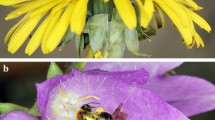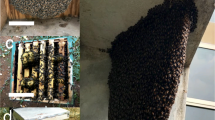Abstract
An ‘I see you’ (ISY) prey–predator signal can co-evolve when such a signal benefits both prey and predator. The prey benefits if, by producing the signal, the predator is likely to break off an attack. The predator benefits if it is informed by the signal that the prey is aware of its presence and can break off what is likely to be an unsuccessful and potentially costly hunt. Because the signal and response co-evolve in two species, the behaviour underlying an ISY signal is expected to have a strong genetic component and cannot be entirely learned. An example of an ISY signal is the ‘shimmering’ behaviour performed by Asian hive bee workers in the presence of their predator Vespa velutina. To test the prediction that bee–hornet signalling is heritable, we let honey bee workers of two species emerge in an incubator so that they had never been exposed to V. velutina. In Apis cerana, the shimmering response developed 48 h post-emergence, was strong after 72 h and increased further over 2 weeks. In contrast, A. mellifera, which has evolved in the absence of Asian hornets, did not produce the shimmering signal. In control tests, A. cerana workers exposed to a non-threatening butterfly did not respond with the shimmering signal.


Similar content being viewed by others
References
Abrol DP (2006) Defensive behaviour of Apis cerana F. against predatory wasps. J Apic Sci 50:39–46
Bergstrom CT, Lachmann M (2001) Alarm calls as costly signals of antipredatory vigilence: the watchful babbler game. Anim Behav 61:535–543
Blumstein DT (2007) Feeling the heat: ground squirrels heat their tails to discourage rattlesnake attack. Proc Nat Acad Sci U S A 104:14177–14178
Butler CG (1974) The world of the honeybee. Collins, London
Caro TM (1986) The functions of stotting in Thompson’s gazelles: some tests of the predictions. Anim Behav 34:663–684
Caro TM (1995) Pursuit-deterrence revisited. Trends Ecol Evol 10:500–503
Clark RW (2005) Pursuit-deterrent communication between prey animals and timber rattlesnakes (Crotalus horridus): the response of snakes to harassment displays. Behav Ecol Sociobiol 59:258–261
Fuchs S, Tautz J (2011) Colony defence and natural enemies. In: Hepburn HR, Radloff SE (eds) Honeybees of Asia. Springer, Heidelberg, pp 369–395
Hasson O (1991) Pursuit-deterrent signals: communication between prey and predator. Trends Ecol Evol 6:325–329
Ken T, Hepburn HR, Radloff SE, Yusheng Y, Yiqiu L, Danyin Z, Neumann P (2005) Heat-balling wasps by honeybees. Naturwissenschaften 92:492–495
Kloft W, Schneider P (1969) Gruppenverteidigungsverhalten bei wildlebenden Bienen (Apis cerana Fabr.) in Afghanistan. Naturwissenschaften 56:219
Koeniger N, Fuchs S (1975) Zur Kolonieverteidigung der asiatiche Honigbienen. Zeitschrift für Tierpsychologie 37:99–106
Oldroyd BP, Wongsiri S (2006) Asian honey bees. Biology, conservation and human interactions. Harvard University Press, Cambridge
Ono M, Okada I, Sasaki M (1987) Heat production by balling in the Japanese honeybee Apis cerana japonica as a defensive behavior against the hornet, Vespa simillima xanthoptera (Hymenoptera: Vespidae). Experientia 43:1031–1032
Ono M, Igarashi T, Ohno E, Sasaki M (1995) Unusual thermal defence by a honeybee against a mass attack by hornets. Nature 377:334–336
Rao D, Diaz-Fleischer F (2012) Characterization of predator-directed displays in Tephritid flies. Ethology 118:1165–1172
Rösch GA (1925) Untersuchungen über die Arbeitsteilung im Bienenstaat. I Die Tätigkeiten im normalen Bienenstaat und ihre Beziehungen zum Alter der Arbeitsbienen. Z Vergl Physiol 2:571–631
Rundus AS, Owings DH, Joshi SS, Chinn E, Giannini N (2007) Ground squirrels use an infrared signal to deter rattlesnake predation. Proc Nat Acad Sci U S A 104:14372–14376
Ruxton GD, Sherratt TN, Speed MP (2004) Avoiding attack: the evolutionary ecology of crypsis, warning signals and mimicry. Oxford University Press, Oxford
Sakagami SF (1960) Preliminary report on the specific differences in behaviour and other ecological characters between European and Japanese honey bees. Acta Hymenopterologica 1:171–198
Seeley TD, Kolmes SA (1991) Age polyethisms for hive duties in honey bees—illusion or reality? Ethology 87:284–297
Sendova-Franks A (2012) Hornet’s response to honeybee signal. Anim Behav 83:869–870
Tan K, Radloff SE, Li JJ, Hepburn HR, Yang MX, Zhang LJ, Neumann P (2007) Bee-hawking by the wasp, Vespa veluntina, on the honey bees A. cerana and A. mellifera. Naturwissenschaften 94:469–472
Tan K, Wang Z, Li H, Yan S, Hu Z, Kastberger G, Oldroyd BP (2012) An ‘I see you’ prey–predator signal between the Asian honeybee (Apis cerana) and the hornet (Vespa velutina). Anim Behav 83:879–882
Vega-Renondo F, Hasson O (1993) A game-theoretic model of predator–prey signalling. J Theor Biol 162:309–319
Verplanck WS (1955) Since learned behavior is innate and vice versa, what now? Psych Rev 62:140–144
Walther FR (1969) Flight behaviour and avoidance of predators in Thompson’s gazelle (Gazella thomsoni Guenther 1884). Behaviour 34:184–221
Acknowledgments
This work was supported by the Key Laboratory of Tropical Forest Ecology, Xishuangbanna Tropical Botanical Garden, Chinese Academy of Science and China National Research Fund (31260585) to KT.
Author information
Authors and Affiliations
Corresponding author
Additional information
Communicated by: Sven Thatje
Rights and permissions
About this article
Cite this article
Tan, K., Wang, Z., Chen, W. et al. The ‘I see you’ prey–predator signal of Apis cerana is innate. Naturwissenschaften 100, 245–248 (2013). https://doi.org/10.1007/s00114-013-1019-4
Received:
Revised:
Accepted:
Published:
Issue Date:
DOI: https://doi.org/10.1007/s00114-013-1019-4




